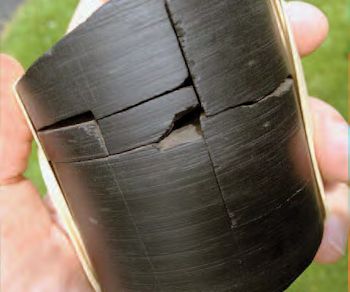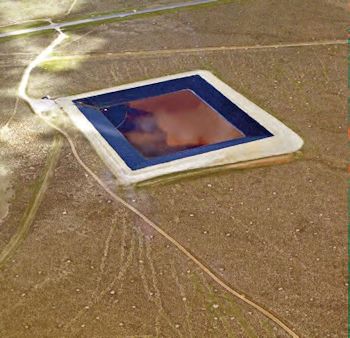SEJournal Online is the digital news magazine of the Society of Environmental Journalists. Learn more about SEJournal Online, including submission, subscription and advertising information.
Special Report
By BOBBY MAGILL
Coverage Basics, Questions To Ask in Reporting on Spread of Shale Oil and Gas Development
 |
| A section of Marcellus shale that's been fracked. Deep under the earth, fracking opens fissures in the shale that allow oil and gas to seep into the hole left behind from drilling. The gas is then pumped up and out of the well. Photo by Adam Hinterthuer, IJNR |
When northeast Colorado’s shale oil and gas boom kicked off in 2009, it wasn’t obvious how hydraulic fracturing, or fracking, would change the landscape, the air quality or the economy in the region.
But change it did: After an exploratory oil well drilled into Northern Colorado’s Niobrara shale produced more than 1,500 barrels of oil in 24 hours, sleepy agricultural towns saw crude oil pumpjacks and new oil company jobs appear seemingly overnight.
And then the boom came to suburbia north of Denver.
In a neighborhood called Sharpe Farms near the town of Dacono, CO, there are two traffic circles marking the entrances to the subdivision. Within each roundabout is an oil and gas well pumpjack connected to 300-barrel crude oil tanks positioned a few hundred feet away.
Such a scene is proof that fracking is no longer something that happens in the middle of far-off oil fields. The industry has become a permanent resident of towns, housing developments and the surrounding farmland.
Today, Colorado is far from the nation’s leading producer of shale oil and gas, but Weld County, the suburban county north of Denver with the heaviest energy development, has more than 18,000 active oil and gas wells, many of which were drilled since 2009.
As the United States surpasses Saudi Arabia to become the globe’s leading producer of oil, the shale boom is felt all over the country, well beyond the biggest shale oil and gas plays.
Even though Texas, Pennsylvania and North Dakota produce the most shale oil and gas from fracking, development is occurring or could occur in places not well known for oil and gas fields, according to the U.S. Energy Information Administration: Arkansas, Illinois, Indiana, Georgia, Michigan, New York and elsewhere.
New pipelines are radiating out from those oil and gas fields while tanker trains carrying volatile crude oil are riding the rails throughout the country.
And studies from Princeton, Cornell, Duke and other universities show that oil and gas wells may be leaking large amounts of methane, a potent greenhouse gas helping to drive climate change.
What exactly is fracking?
The term fracking is shorthand for hydraulic fracturing, a process used since the 1940s that involves high-pressure injections of water, sand and chemicals into oil and gas wells, cracking open thin layers of rock thousands of feet underground.
Those rock formations, usually shale or other sedimentary rocks, were once thought to be too dense or “tight” to be porous enough to allow the hydrocarbons trapped in the rock to flow into an oil and gas well bore and be extracted economically.
Over the last decade, however, energy companies found a way around that problem with technological advancements in fracking and directional drilling.
Directional or horizontal drilling is a technique that allows a company to drill a vertical well bore, then angle it 90 degrees so the company can drill horizontally through a rock formation, providing greater access to the oil and gas trapped there.
When fracking occurs, the company injects water and chemicals at high pressure in several stages, creating fractures in the rock that allow hydrocarbons to flow into a well. The sand injected into the well with the fluid helps keep the fractures open and oil and gas flowing into the well.
The well bore hole is cased in steel and concrete to prevent chemicals from leaking into aquifers before fracking fluid is injected.
No one frack fits all sizes
Nearly every frack job is different. The chemical composition of fracking fluid and the amount of water used depend on numerous factors, primarily the geology and depth of the oil and gas deposit the energy company is trying to tap.
Some fracking operations use a handful of chemicals and a few hundred thousand gallons of water. Others use dozens of chemicals and more than five million gallons of water.
In many cases, some of the fracking chemicals used are considered trade secrets and cannot be publicly disclosed. Some states such as Colorado, however, require companies to disclose the chemicals to state officials in the event of an emergency.
Before these technological advancements, only one well could be built in one spot and it could only access oil and gas that were free-flowing deep underground. These older wells are called “conventional” wells, and wells using the new technology to extract oil and gas from tight rocks are called “unconventional” wells.
Fracked unconventional wells often produce both oil and natural gas, but sometimes they produce one or the other.
It is these advancements in fracking and drilling technology, which allow dozens of wells to be drilled from a single location, that have enabled energy companies to produce enough oil and gas to make the U.S. the world’s leading producer of crude oil and natural gas.
Environmental costs still not well known
 |
| An aerial image of a "produced" water evaporation pond in Pavillion, WY, where the mixture of water, sand and chemicals used in fracking is stored after it’s brought back to the surface. Photo by EcoFlight.org |
Fracking came to Colorado’s suburbs with a cost: Heavy truck traffic, noise, oil and fracking fluid spills, air quality challenges, earthquakes and many other environmental concerns.
The same is true in Texas, where the oil fields in the Eagle Ford shale south of San Antonio are the biggest producers of crude oil in the U.S. and may be the source of air pollution in south Texas.
In Pennsylvania, the natural gas industry has drilled and fracked thousands of wells in the Marcellus shale in the western and northern parts of the state, the most productive natural gas field in the United States.
Residents in the region have voiced concern about water contamination from fracking there, and studies have shown the natural gas production there to be a major source of methane emissions.
It’s a similar story in North Dakota, where the headlong rush to drill for crude oil in the Bakken shale has turned Williston, N.D., into a boomtown and the state as a whole into one of the nation’s most prosperous. Fracking has dropped North Dakota’s unemployment rate to below 3 percent, the lowest in the nation.
In addition to a roaring economy, Bakken oil fields are known for three other things: The flames from natural gas being burned off oil wells in North Dakota can be seen from space. The highly volatile crude oil produced there is shipped in freight trains, several of which have been involved in deadly and explosive derailments in the last two years. And, the Bakken fields are slated to be linked into the Keystone XL Pipeline if it is ever built.
The fracking boom is turning the United States into a global powerhouse of oil and gas production, but the environmental consequences aside from the industrialization of residential areas and wild lands are just being investigated.
Questions to ask, answers to be found
For journalists, the shale oil and gas boom is a trove of stories of struggle and prosperity and unanswered environmental questions.
For instance, does fracking cause earthquakes? If so, you as a reporter might ask if the energy company doing the fracking is responsible if houses are damaged.
Or you might ask, how many oil and gas spills are occurring in my neighborhood? How many inspectors are keeping tabs on the wells in my state, and why aren’t there more? Whose property could soon be crisscrossed by new oil and gas pipelines? How many crude oil tanker trains pass through my town? What are the oil wells in our neighborhoods doing to property values? Is fracking affecting groundwater? What does it mean for children’s health when fracking occurs near a school?
Many state regulators’ websites are ripe for data mining, allowing you to learn what areas are being leased for oil and gas development, how much oil and gas is being produced there, where spills and water contamination are occurring and how much companies have been fined for breaking the rules.
Some states are more transparent than others with rules enforcement data available online, so don’t hesitate to file open records requests for data not available online.
Overall, though, online resources are abundant to help you find answers to questions about fracking, and a good place to start is SEJ’s own online fracking reporting toolbox.
Here are some other questions you might have about how fracking could be affecting your community, and where to go to find information:
Question: How does fracking work?
- FracFocus.org: FracFocus not only provides a technical overview of the fracking process, but the website is the primary place where energy companies publicly report the locations of their fracking operations, many of the chemicals used in each frack job and how much water was used. Some of the chemicals are listed only as trade secrets and are not disclosed on the website.
- U.S. Energy Information Administration: The EIA provides a plethora of data on oil and gas production across the United States and is a wealth of information about where energy comes from and how it is used. The EIA also features the U.S. Energy Mapping System, which is an interactive mapping tool designed to allow users to search for oil and gas wells and other energy infrastructure anywhere in the country.
- National Energy Technology Laboratory: The NETL publishes and periodically updates comprehensive primers on fracking and shale oil and gas development in the U.S., a good source for a technical overview of the fracking process.
- FracTracker Alliance: Once a project of the University of Pittsburgh, the FracTracker Alliance tracks the spread and impact of shale oil and gas development across the United States and features interactive maps and data on its website.
 |
| Drill bits with synthetic diamond tips like this one are often so expensive that oil and gas companies lease them for jobs, rather that buy them outright. This particular bit helped bore a hole nearly two miles long. Photo by Adam Hinterthuer, IJNR |
Question: Where are spills occurring and what are they doing to the air and water?
- EPA: The U.S. Environmental Protection Agency is in the process of writing a rule that may govern how the air and water are affected by fracking. The EPA also features technical documents on its fracking website that describe the fracking process and many of its risks.
- GAO: The U.S. Government Accountability Office has published numerous reports on shale oil and gas and their economic and environmental impacts.
- States: Individual state regulators’ websites are often the best places to find information on oil and gas related spills and releases and other related permitting information. Every state’s level of reporting and disclosure is different, and some states may require an open records request for data that others may provide online for free.
Here are regulators’ websites for selected states:
- The Colorado Oil and Gas Conservation Commission: The COGCC provides a wealth of data on oil and gas well permits, spills and releases, fines and much, much more.
- The North Dakota Oil and Gas Division: This website features oil and gas statistics for the state of North Dakota, as well as searchable maps, drilling activity reports and more.
-The Texas Railroad Commission: Texas’ chief oil and gas regulator posts periodic reports on environmental and oil and gas rules compliance enforcement. The TRRC also features a searchable map of oil and gas infrastructure on its website.
-The Pennsylvania Department of Environmental Protection: Pennsylvania’s oil and gas regulator’s website includes data on oil and gas well permitting, environmental compliance, drilling activity and more.
Question: Does fracking cause earthquakes?
- The U.S. Geological Survey: The USGS not only operates an online map which shows earthquakes occurring in real time, but USGS scientists are conducting ongoing research about how fracking and fracking wastewater injection might induce earthquakes. For example, a new USGS study published Sept. 15 in the Bulletin of the Seismological Society of America shows that fluid injection association with fracking is the cause of earthquakes in the Raton Basin of Colorado and New Mexico, an area of heavy coalbed methane development.
Question: How might fracking affect public health where I live?
- The Colorado School of Public Health has conducted some of the most comprehensive studies on the effects of oil and gas development on public health so far, but researchers there have said there is much scientists don’t know about how fracking affects health. A listing of recent public health studies was compiled by ProPublica earlier this year.
Bobby Magill covers energy and climate change as a senior science writer at Climate Central in New York. He previously covered energy, fracking, public lands and other environmental issues for a decade at the Fort Collins Coloradoan, Grand Junction Daily Sentinel and other newspapers in New Mexico and Colorado, and has freelanced for Popular Mechanics, New West and High Country News.
* From the quarterly newsletter SEJournal, Fall 2014. Each new issue of SEJournal is available to members and subscribers only; find subscription information here or learn how to join SEJ. Past issues are archived for the public here.













 Advertisement
Advertisement 



